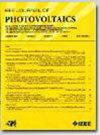Impact of Fast-Firing Conditions on Light- and Elevated-Temperature-Induced Degradation (LeTID) in Ga-Doped Cz–Si
IF 2.5
3区 工程技术
Q3 ENERGY & FUELS
引用次数: 2
Abstract
The fast-firing step commonly applied at the end of solar cell production lines triggers “Light- and elevated-Temperature-Induced Degradation” (LeTID) effects of the carrier lifetime in Ga-doped Cz–Si wafers and solar cells made thereof. As far as the defect formation within the silicon bulk is concerned, the key parameters of the fast-firing step are the peak firing temperature (快速点火条件对光的影响- 和Ga掺杂Cz–Si中的高温诱导降解(LeTID)
通常应用于太阳能电池生产线末端的快速烧制步骤触发了Ga掺杂Cz–Si晶片及其制成的太阳能电池中载流子寿命的“光和高温诱导降解”(LeTID)效应。就硅块体内的缺陷形成而言,快速烧制步骤的关键参数是峰值烧制温度(FT)和传送带的带速度vband,其中后者主要定义烧制峰值之后的冷却斜坡。在这一贡献中,我们发现LeTID的程度和降解过程中对施加温度的依赖性随着测量的FT(从680°C到800°C)、vband(从2.8到7.2 m/min)的增加而强烈增加,以及沉积在晶片表面的富氢氮化硅层的折射率n(从2.07到2.37)。通过温度相关的降解实验,我们确定了Ga掺杂Cz–Si中LeTID机制的激活能EA=(0.55±0.10)eV,它与FT和vband无关。根据这一观察结果,我们得出结论,单个缺陷激活机制最有可能是所检查的LeTID效应的原因,与发射条件无关。然而,LeTID之后的复合活性缺陷中心的浓度主要取决于FT、vband和n,我们将其归因于烧制过程中来自氮化硅层的扩散氢浓度的变化。因此,我们的实验表明,在Ga掺杂的Cz–Si中观察到的LeTID机制中涉及氢。
本文章由计算机程序翻译,如有差异,请以英文原文为准。
求助全文
约1分钟内获得全文
求助全文
来源期刊

IEEE Journal of Photovoltaics
ENERGY & FUELS-MATERIALS SCIENCE, MULTIDISCIPLINARY
CiteScore
7.00
自引率
10.00%
发文量
206
期刊介绍:
The IEEE Journal of Photovoltaics is a peer-reviewed, archival publication reporting original and significant research results that advance the field of photovoltaics (PV). The PV field is diverse in its science base ranging from semiconductor and PV device physics to optics and the materials sciences. The journal publishes articles that connect this science base to PV science and technology. The intent is to publish original research results that are of primary interest to the photovoltaic specialist. The scope of the IEEE J. Photovoltaics incorporates: fundamentals and new concepts of PV conversion, including those based on nanostructured materials, low-dimensional physics, multiple charge generation, up/down converters, thermophotovoltaics, hot-carrier effects, plasmonics, metamorphic materials, luminescent concentrators, and rectennas; Si-based PV, including new cell designs, crystalline and non-crystalline Si, passivation, characterization and Si crystal growth; polycrystalline, amorphous and crystalline thin-film solar cell materials, including PV structures and solar cells based on II-VI, chalcopyrite, Si and other thin film absorbers; III-V PV materials, heterostructures, multijunction devices and concentrator PV; optics for light trapping, reflection control and concentration; organic PV including polymer, hybrid and dye sensitized solar cells; space PV including cell materials and PV devices, defects and reliability, environmental effects and protective materials; PV modeling and characterization methods; and other aspects of PV, including modules, power conditioning, inverters, balance-of-systems components, monitoring, analyses and simulations, and supporting PV module standards and measurements. Tutorial and review papers on these subjects are also published and occasionally special issues are published to treat particular areas in more depth and breadth.
 求助内容:
求助内容: 应助结果提醒方式:
应助结果提醒方式:


